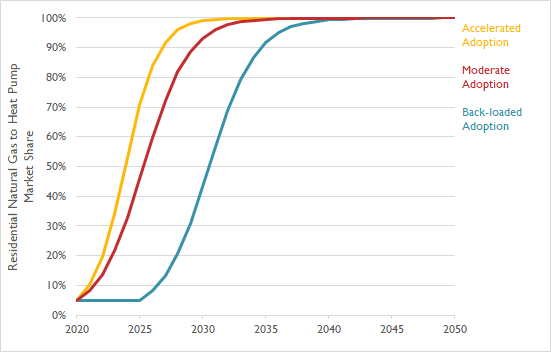Timing Is Everything for New York Building Decarbonization
Building decarbonization—particularly through widespread adoption of heat pumps for space and water heating—is now a central strategy for New York State to meet its climate targets. The installation of heat pumps can cost-effectively reduce greenhouse gas emissions in the building sector, but the timing of system replacements is crucial.
The Natural Resources Defense Council (NRDC) tasked Synapse with developing intermediate and long-term benchmarks for heating electrification to ensure that the State of New York is on a path to meet its net zero greenhouse gas emissions goal by 2050. Decarbonizing space and water heating through heat pump installations offers the state a relatively easy and low-cost avenue for emissions reductions, especially when compared to lowering emissions in sectors that may be tougher to decarbonize, such as industry and agriculture. For this assessment, Synapse used its Building Decarbonization Calculator and evaluated three separate adoption trajectories to reach New York’s goal of net zero emissions by 2050.
A Matter of Timing
One of the challenges of achieving building sector electrification is the long lifetime of fossil-fuel-based heating systems. A new natural gas furnace installed in the coming years may need to be replaced before the end of its useful life for New York to achieve complete decarbonization by 2050. This early retirement of functioning equipment can be more costly than planning ahead and installing low-carbon heating systems when existing systems need replacement.
Synapse modeled three different trajectories to reach a carbon-free building sector in 2050:
Back-Loaded Heat Pump Adoption
This pathway keeps the current installation rate of heat pumps constant for 2020–2025. To reach New York’s 2050 carbon-free goal, substantial numbers of early replacement heat pump installations occur in the late 2040s.
Moderate Heat Pump Adoption
This scenario achieves near 100 percent heat pump market share by 2031 for residential buildings and by 2033 for commercial buildings. These trajectories still necessitate some early replacement of systems in the 2040s.
Accelerated Heat Pump Adoption
This pathway demonstrates a trajectory that accelerates heat pump adoption even more rapidly to take advantage of the full period between now and 2050 to electrify the state’s buildings. The accelerated adoption scenario results in the fewest early, and more costly, system replacements.
Residential Natural Gas to Heat Pump Market Share

Synapse modeling found that heat pumps need to make up 95–100 percent of new residential space heating installations by 2030 in order to avoid a large number of early system replacements before 2050. This equates to 2.1-2.5 million New York households heating with heat pumps by 2030.
Getting an early start on heat pump adoption allows the state’s building sector to spend the next three decades focusing on more cost-effective replacements at end-of-system life, rather than investing money into fossil fuel heating systems that will need to be replaced while they are still functional.
A Few Data Caveats
- Throughout our analysis, we categorized all households in New York as being in the residential sector, even though large multifamily residential buildings may require different types of heat pump systems than single-family homes. We measure the sizes of heat pump systems by the number of households they serve. For example, one large heat pump system serving 100 apartments is modeled as 100 individual heat pump systems.
- New York City’s extensive district steam system is not included in our transition estimates. Additional research will be required to determine the best way to ensure homes relying on district steam will be emissions-free by 2050. Currently, district steam systems are responsible for less than 5 percent of total building-sector emissions.
- Our modeling did not include on-site residential emissions from cooking, clothes drying, and other end-uses.
Visit NRDC's blog post to read more on New York's building decarbonization targets.
View the full results of Synapse's analysis here.